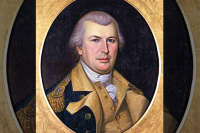Don’t rush by this little Lake Junaluska treasure
I traveled over the Balsams this past weekend from Sylva to Lake Junaluska for a native plant sale, and I’m very glad that I set time aside to make the trip. Not only were there some nice specimens to be had, I was able to tour the Corneille Bryan Native Garden.
I did know the garden was there, though many folks in the region don’t realize this tiny labor of love exists in Haywood County. I used to run regularly at Lake Junaluska before going to work weekday mornings at a regional office for the Asheville Citizen-Times in Waynesville. I’d sometimes trot through the garden area, dropping off County Road through the garden on my way back to the lake, happy for a bit of trail under my feet instead of pavement. Or, for variety, I’d run up the hill from the lake area to the road, optimistically dubbing my crawling, gasping effort a “hill workout” in my running journal.
No matter how pathetic and slow the actual effort, running through a garden is not a mindful way to enjoy flowers. Most of my attention, frankly, was devoted to not falling flat on my face. So the opportunity to stroll leisurely through was a delight, heightened by chats beforehand with garden director Janet Manning and Linda McFarland. Linda, in 2003, helped Janet Lilley put together a book, “Seasons in a Wildflower Refuge,” on what one can enjoy there. Well-known regional botanist Dan Pitillo, now retired from Western Carolina University, wrote descriptions for the book of the garden’s plants.
The genesis of the garden dates to the summer of 1989, according to a brochure about the Lake Junaluska site. Tuscola Garden Club members had been discussing the need to encourage more native plantings on the Junaluska Assembly grounds. Maxilla Evans (who died in December 2007) expressed a desire for a place where her lifetime collection of wildflowers could be preserved; and the family of Corneille Downer Bryan was looking for a suitable memorial. Bryan was a nature lover, artist and member of the Tuscola Garden Club.
So began the Corneille Bryan Native Garden, now home to about 500 various trees, shrubs and herbaceous plants. These include shortia, which is native to only an extremely limited area, pinkshell azalea, and various trillums. An endowment through the Bryan family helps maintain the garden.
The garden’s “primary function is to serve as a place of respite and renewal for all who draw strength from the beauty and quiet of this place,” the writers of the brochure note.
Related Items
I believe what interests me most is how well Manning and the others involved are using such limited space — limited in both terms of size and context. The garden, as noted earlier, is on a fairly steep hill in a ravine, with a mix of oaks, black walnut and locust overhead. The area had become a dump for trash before the garden was created, with new steps, paths and bridges built, and a variety of habitats created.
Manning said the group is working to complete a bog section now. This is only one of many habitats featuring a variety of shade-loving and sun-loving native plants. (Much of the ravine is shaded, but a small area (euphemistically dubbed the “sunny meadow”) gets light. There you can find asters, penstemon, columbine and more).
There is much to enjoy and learn from the Corneille Bryan Native Garden. If you take the time to stop and smell the roses, that is, and not run mindlessly through. If there were any roses … but you get the point, I’m sure.
To get there, go to Lake Junaluska Assembly. You can get to the garden on Stuart Circle from Lakeshore Drive, or by turning off County Road onto Oxford Road or Ivey Lane. Go to www.lakejunaluska.com/facility-maps for even better directions — click on “grounds map.”
(Quintin Ellison can be reached at This email address is being protected from spambots. You need JavaScript enabled to view it..)









